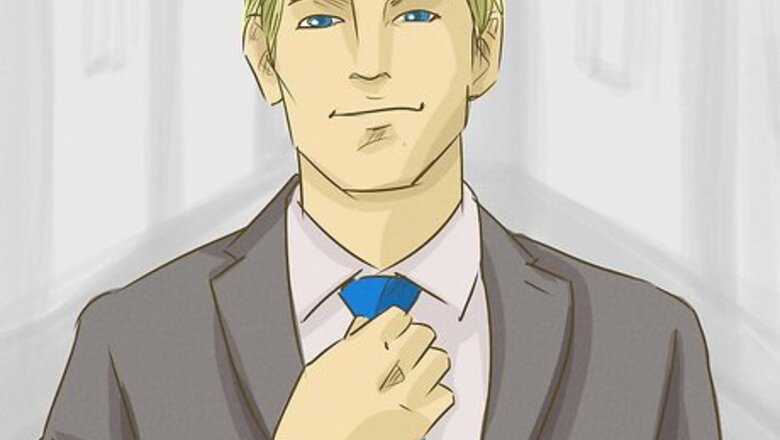
views
Dealing with Nerves

Change your language. You may feel butterflies in your stomach or tightness in your chest. Consider that, in our bodies, nervous energy and excited energy often feel very similar. Therefore, it may not be hard to have your brain make the switch as well. Tell yourself “I’m so excited to meet this person!” rather than “I’m so nervous!” and see how your outlook changes. It’s easier to tell yourself that you’re excited, rather than to calm down, when you are anxious. You already have all the physiological responses of excitement going on, so it’s easier to make yourself believe you are excited, rather than force yourself to calm down — which is at the opposite end of the physiological spectrum. For example, you may have an important meeting with your bank coming up. Instead of thinking, “I’m dreading this meeting,” you could tell yourself, “I am so excited to meet to talk about this loan!” It sounds silly, but if you laugh at yourself, even better! That will help you relax. Tell yourself how you are anticipating your meeting rather than being worried about it. For example, “I can’t wait to meet with my new boss tomorrow!” If you can tell other people as well, even better. The more ways we can get the brain to process this as a positive event, the better. Call a friend and tell them how much you are looking forward to meeting the person.

Breathe. Try to clear your mind of worries and focus on your breathing. Breathing is one of the best ways to reduce stress. Just ensure you are taking deep breaths (into your abdomen, not your chest) to get the benefits of stress relief and relaxation. Shallow breathing can make you feel anxious. A good way to make sure you are breathing into your abdomen is to your hands on belly button, and watch them rise and fall. Your belly should lift your hands and your chest should not move. If you can, try lying down and feeling your belly rise and fall with air. Focus on nothing but your breathing for a few minutes. If you are not able to lie down, sit with your eyes closed, and practice breathing, perhaps using a word or image to help you relax. EXPERT TIP Dr. Niall Geoghegan, PsyD Dr. Niall Geoghegan, PsyD Clinical Psychologist Dr. Niall Geoghegan is a Clinical Psychologist in Berkeley, CA. He specializes in Coherence Therapy and works with clients on anxiety, depression, anger management, and weight loss among other issues. He received his Doctorate in Clinical Psychology from the Wright Institute in Berkeley, CA. Dr. Niall Geoghegan, PsyD Dr. Niall Geoghegan, PsyD Clinical Psychologist Dealing with anxiety is a challenge. Niall Geoghegan, a clinical psychologist, says: “Anxiety is inevitable. We are all going to feel anxious at some point, but one of the key things to know is that you can go into an anxiety-producing situation, let the anxiety rise, and let it move through you. You’re still there; it doesn’t kill you.”

Relax your muscles. Softening and relaxing the muscles communicates to the brain that there is nothing to worry about in the environment around you. When nervous, many people pace, bounce a leg, pick at their clothes, clench their jaws, wring their hands, etc. This alarms the brain and initiates panic. Progressive muscle relaxation — tensing then releasing your muscles methodically — may help you calm down. Try doing a “body scan,” starting from the top of the head and scanning down to the tip of the toes, relaxing every muscle along the way. Try these techniques in the hours or even days before the encounter, then try it right before meeting the person. This allows you to walk into the situation without tension in your body and without nervous tics like those listed above.

Clear your head with meditation. Meditation can help you relax, de-stress, and get focused for your meeting. It will help you feel calmer by lowering your blood pressure. While meditation takes some practice, simply closing your eyes, breathing deeply, and clearing your mind through focusing on your breath can be beneficial. If you are stressed about an upcoming meeting a few days away, you could set aside some time each to day to relax using meditation. The extra practice will improve your meditation skills, but will also give you greater calm and focus. You can find guided meditations online or download meditation apps to help you.

Remember, they are a person just like you. Even if you are meeting the Pope or the Prime Minister, remember, they are just another human being. Do not make them any larger-than-life than they are. Stay positive and open-minded, but keep practical expectations. For example, you may be nervous about meeting someone you met online for a first date. They may seem like Mr. or Ms. Right from their profile, but stay open-minded to the possibility that they very well might not be. Readjust your outlook from “first date” to “getting to know someone better.”
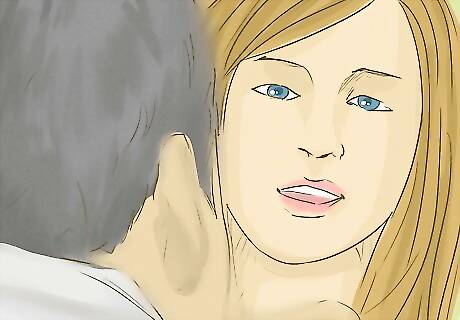
Go easy on yourself. Don’t get anxious about making mistakes. Things happen, and most of the time, you will find other people gracious and willing to help you out. And if they are not, your encounter will not last forever. Once you get some distance from the meeting, you will probably find a way to find some humor in it (or at least your friends will). Yes, it’s possible you may have a foot-in-mouth moment when you are meeting someone for the first time, but don’t obsess over such a scenario. If it happens, apologize, admit your embarrassment, and move on. Think of a graceful apology if you make a mistake. For example, if you have been calling this person by the wrong name for the past hour, you could say, “Oh my goodness, I am so embarrassed! Please accept my apology!”
Visualizing a Successful Encounter

Imagine your conversation. If you are nervous about what you are going to say or do, try visualizing it in your mind. Imagine the scene in detail. Visualization allows you to imagine the successful outcome of your encounter, and help you become more confident because you have “prepared” for it in your mind’s eye. This preparation teaches your brain to respond in this way when another similar event occurs. Visualize all the details of your encounter. If you are visualizing meeting a potential employer at a job interview, for example, you may wish to visualize yourself driving up to the interview location, walking up to the building, and finding the correct office. Visualize the suit you will wear to the interview, shaking hands with the interviewer, and sitting down at a table. Continue this process and visualize the entire interview. Allow yourself to feel the emotions you would ideally like to have when you meet this person. For a job interview, you might want to imagine yourself feeling confident, prepared, and excited to learn more about this new opportunity. Incorporate all of your senses into your visualization. If you are picturing a first date at an Italian restaurant, smell the garlic and marinara in the air. Taste the lasagna you will order. Visualize positive outcomes. Imagine a successful job interview, a fun first date, or a productive meeting with a new supervisor. You can also visualize an actual encounter from your past that went well. This can trigger memory of strategies that worked well while also framing the upcoming encounter in a hopeful light.
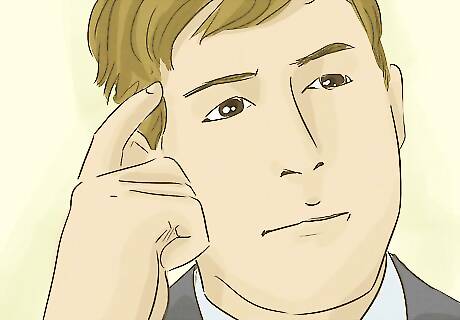
Practice visualizing regularly. Make it a daily habit, first thing in the morning or the last thing you do before you fall asleep. Successful visualization takes practice and commitment. Think of it like exercise: the more you do it, the stronger you get, and the easier it gets. Close your eyes and sit up straight during your practice, so you don’t accidentally doze off. You may wish to work with this in conjunction with a meditation practice. You may wish to close your visualization exercise with an affirmation, like “I am confident and brave,” or “I’ve got this!”
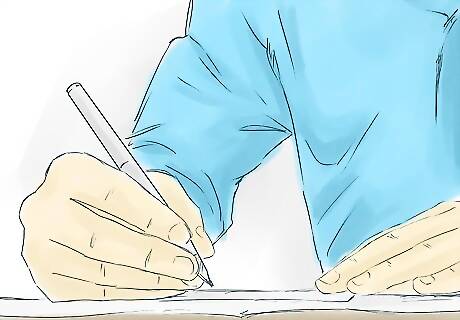
Write it down. Another effective way to visualize is to write down how you would like your meeting to go. Writing out your visualization allows you to focus even further, and also allows you to return to the same visualization again and again by rereading your words. Write your visualization in a private place, like in a journal, or put it in an electronic document that you can pull up easily. Consider reading it on your phone during your commute, for example.
Conveying Confidence

Have a positive attitude. Staying positive will help you remain calm and looking forward to meeting this new person. Plus, the other person will find it much easier to interact with you when you appear positive and receptive to talking to them. Give yourself a mini-pep talk with a word or phrase meant to help you stay centered and positive, like “Go get ‘em!” or “Stay strong!” Think well of yourself. Believe in your ability to have a successful encounter with this new person. For inspiration, think about all of the ways you are successful in your life: You can do all those things, and you can do this, too!

Dress to impress. Wear an outfit appropriate to the occasion that you look and feel good in. For a job interview, you may want to wear a suit or other clothing appropriate for an office setting. For a first date, you may wish to wear jeans and a nice sweater, or your favorite dress. For professional settings, it’s okay to wear clothes that convey your personality (such as a brightly-colored blouse, eye-catching statement jewelry, or a colorful tie), just be sure you don’t overdo it! When it doubt, aim for a more conservative look.
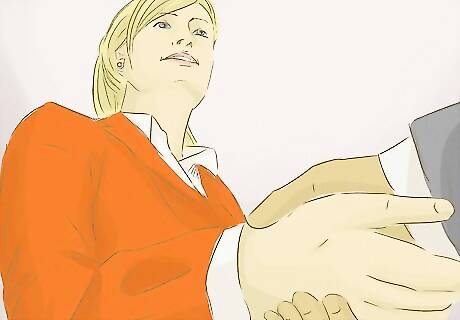
Use confident body language. Your body language conveys lots of information about you to the other person. Convey confidence and positive energy by standing up straight, making eye contact, and smiling when you greet the person. Shake hands. Greet the person with a confident, firm handshake. Make sure you look them in the eye while you are shaking hands.
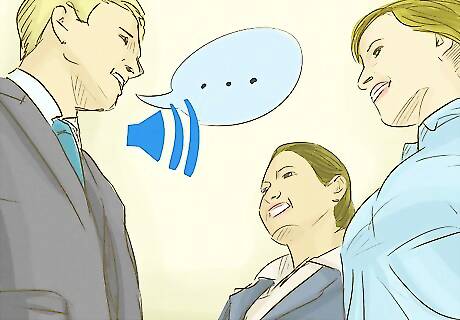
Speak clearly. Make sure you speak loud enough so that other people can hear you, and that you are looking at the other person, not at your feet, when you greet them. A clear, articulate, warm speaking voice makes you appear calm and confident. Also be mindful that you are not speaking too fast, which often occurs when people are nervous. Greet the other person with a warm, friendly hello. Say their name in your greeting. “Hello, Marisol, it’s so nice to meet you!”

Establish a rapport with the other person. Observe the other person in their surroundings, and look for ways to start a conversation. Look for ways to connect with them over common interests. While many people dislike small talk, it is a way to find common ground and begin building a relationship. Look for conversation cues in your surroundings. Look at the other person’s clothing: Is there something they are wearing you could compliment them on? Is there a beautiful piece of artwork on their office wall? Find something to talk about for a few minutes before you settle into the business at hand. If you can’t think of anything, you can always talk about the weather! For example, you may be in a meeting in someone’s office. On their desk is a family picture. You could say, “What a beautiful picture! How old are your children?” For example, your first date is wearing a pin with the name of a political candidate you support. You could point to it and say, “Nice choice! I think she’d make a great mayor!” Take note of the person's name and use it periodically throughout conversation. This makes you seem personable and likable. Also use their name when you thank them or say goodbye at the end of the encounter.




















Comments
0 comment